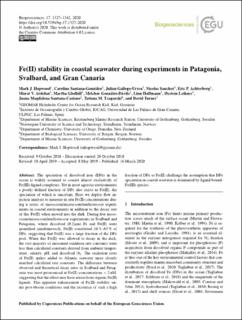| dc.contributor.author | Hopwood, Mark J. | |
| dc.contributor.author | Santana-González, Carolina | |
| dc.contributor.author | Gallego-Urrea, Julian Alberto | |
| dc.contributor.author | Sanchez, Nicolas | |
| dc.contributor.author | Achterberg, Eric P. | |
| dc.contributor.author | Ardelan, Murat Van | |
| dc.contributor.author | Gledhill, Martha | |
| dc.contributor.author | González-Dávila, Melchor | |
| dc.contributor.author | Hoffmann, Linn | |
| dc.contributor.author | Leiknes, Øystein | |
| dc.contributor.author | Santana-Casiano, Juana Magdalena | |
| dc.contributor.author | Tsagaraki, Tatiana Margo | |
| dc.contributor.author | Turner, David | |
| dc.date.accessioned | 2020-12-21T12:30:50Z | |
| dc.date.available | 2020-12-21T12:30:50Z | |
| dc.date.created | 2020-06-10T10:42:25Z | |
| dc.date.issued | 2020 | |
| dc.identifier.citation | Biogeosciences. 2020, 17 1327-1342. | en_US |
| dc.identifier.issn | 1726-4170 | |
| dc.identifier.uri | https://hdl.handle.net/11250/2720588 | |
| dc.description.abstract | The speciation of dissolved iron (DFe) in the ocean is widely assumed to consist almost exclusively of Fe(III)-ligand complexes. Yet in most aqueous environments a poorly defined fraction of DFe also exists as Fe(II), the speciation of which is uncertain. Here we deploy flow injection analysis to measure in situ Fe(II) concentrations during a series of mesocosm/microcosm/multistressor experiments in coastal environments in addition to the decay rate of this Fe(II) when moved into the dark. During five mesocosm/microcosm/multistressor experiments in Svalbard and Patagonia, where dissolved (0.2 µm) Fe and Fe(II) were quantified simultaneously, Fe(II) constituted 24 %–65 % of DFe, suggesting that Fe(II) was a large fraction of the DFe pool. When this Fe(II) was allowed to decay in the dark, the vast majority of measured oxidation rate constants were less than calculated constants derived from ambient temperature, salinity, pH, and dissolved O2. The oxidation rates of Fe(II) spikes added to Atlantic seawater more closely matched calculated rate constants. The difference between observed and theoretical decay rates in Svalbard and Patagonia was most pronounced at Fe(II) concentrations <2 nM, suggesting that the effect may have arisen from organic Fe(II) ligands. This apparent enhancement of Fe(II) stability under post-bloom conditions and the existence of such a high fraction of DFe as Fe(II) challenge the assumption that DFe speciation in coastal seawater is dominated by ligand bound-Fe(III) species. | en_US |
| dc.language.iso | eng | en_US |
| dc.publisher | Copernicus Publications under license by EGU | en_US |
| dc.rights | Navngivelse 4.0 Internasjonal | * |
| dc.rights.uri | http://creativecommons.org/licenses/by/4.0/deed.no | * |
| dc.title | Fe(II) stability in coastal seawater during experiments in Patagonia, Svalbard, and Gran Canaria | en_US |
| dc.type | Peer reviewed | en_US |
| dc.type | Journal article | en_US |
| dc.description.version | publishedVersion | en_US |
| dc.source.pagenumber | 1327-1342 | en_US |
| dc.source.volume | 17 | en_US |
| dc.source.journal | Biogeosciences | en_US |
| dc.identifier.doi | 10.5194/bg-17-1327-2020 | |
| dc.identifier.cristin | 1814733 | |
| dc.description.localcode | © Author(s) 2020. This work is distributed under the Creative Commons Attribution 4.0 License | en_US |
| cristin.ispublished | true | |
| cristin.fulltext | original | |
| cristin.qualitycode | 1 | |

